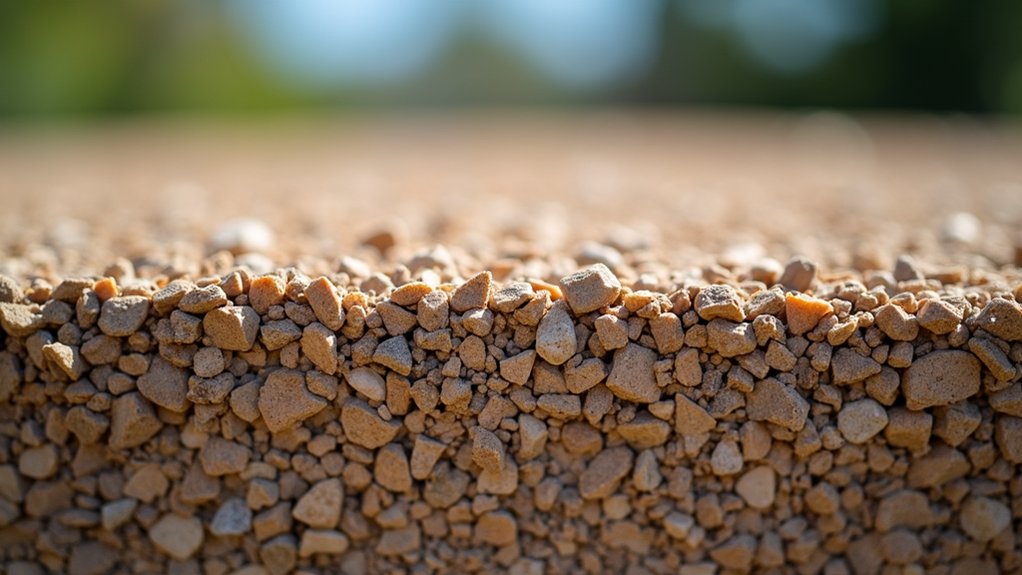A proper sub-base is vital for resin-bound gravel driveways and paths. Think of it as the foundation of a house – without it, the whole structure becomes unstable. The sub-base spreads weight evenly across the surface, much like a mattress distributing body weight, which stops annoying dips and cracks from forming.
Good drainage is equally crucial for British weather. A well-built sub-base helps rainwater drain properly, meeting UK SuDS regulations for sustainable drainage. Getting the basics right – using quality materials at the correct depth and ensuring proper compaction – makes all the difference between a surface that lasts 15+ years and one that fails within months.
Key Takeaways
Five Essential Points About Sub-Base Prep for Resin-Bound Gravel
A proper sub-base ensures your driveway or patio meets UK drainage standards (SuDS), much like having good foundations for your house. Water flows through naturally, rather than pooling on top.
Think of the sub-base as the backbone of your surface – it spreads weight evenly across the ground. Without it, you’d soon spot dips where cars park or high-traffic areas wear down.
The load-bearing strength is crucial, particularly for driveways. A solid sub-base means your resin surface won’t crack when delivery vans pop round or when you’re having work done.
MOT Type 3 aggregate is the go-to material for British weather conditions. It’s like building a strong drainage system beneath your feet, keeping everything stable through rain and frost.
Regular checks of your sub-base save money in the long run. It’s similar to servicing your car – spot issues early, and you’ll avoid major headaches later.
Importance of Sub-Base Preparation
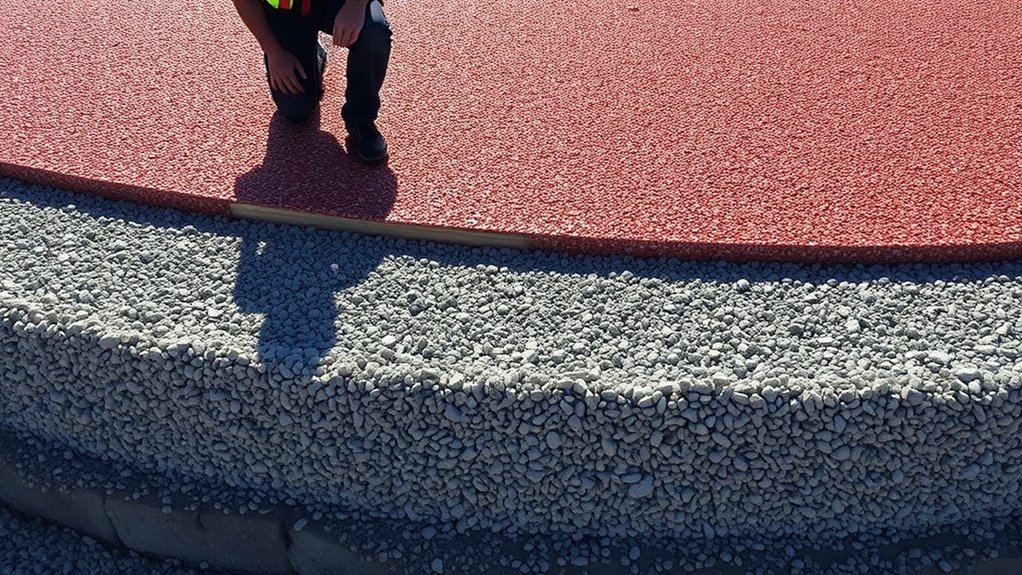
Proper sub-base preparation is crucial for any resin-bound gravel project. Using the right materials, like MOT Type 3, ensures your installation meets SuDS requirements and provides excellent drainage. A well-laid base creates an even surface – think of it as the foundation of a house; if it’s not level, everything above it will be wonky. The sub-base needs to be strong enough to handle whatever will be moving across it, whether that’s foot traffic or vehicles. For example, a driveway needs a more robust base than a garden path. Additionally, proper edge restraints are critical to prevent shifting during installation.
Getting the drainage right is vital too – nobody wants puddles forming after rain. Additionally, the sub-base provides support and stability to the overall construction strength, enhancing the longevity of your installation. A well-installed driveway can last between 15-25 years, reflecting the quality of the sub-base preparation.
While cheaper materials might seem tempting, skimping on sub-base preparation often leads to costly repairs down the line. It’s like buying cheap boots; they might save you money now, but you’ll end up replacing them sooner than quality ones.
A properly prepared sub-base will:
- Support weight effectively
- Allow water to drain naturally
- Prevent surface cracking
- Extend the life of your installation
- Reduce maintenance costs
Functions of the Sub-Base
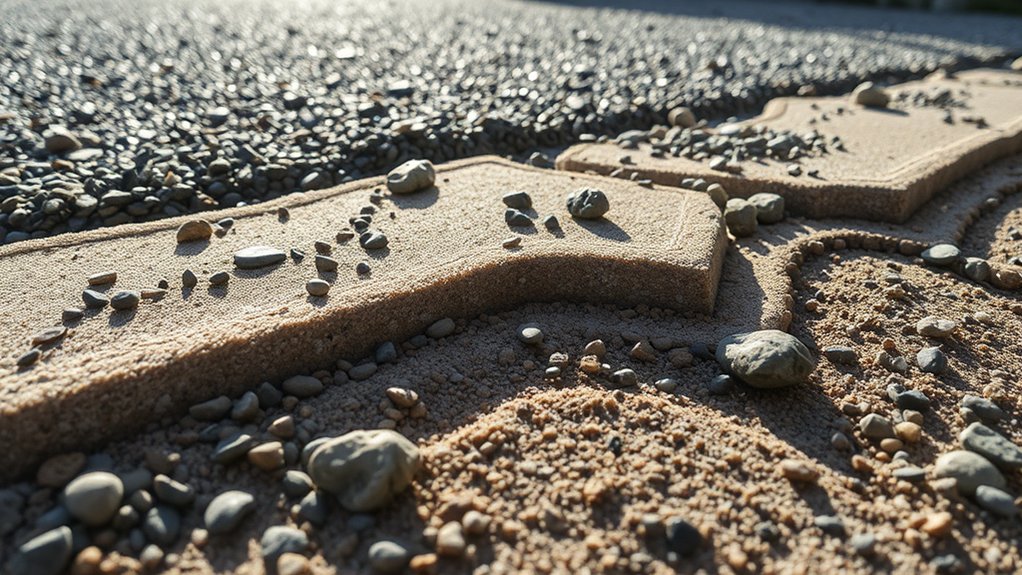
Sub-base works as the foundation layer beneath resin-bound gravel, performing two vital jobs. First, it spreads weight evenly across the surface – much like how a mattress distributes body weight – which stops dips and damage forming when cars or people move across it. Second, it manages rainwater effectively, letting it drain through naturally whilst keeping the surface strong and stable. These functions make it essential for any long-lasting resin-bound driveway or path. The choice of sub-base type also significantly influences the overall installation success and durability of the surface, as a properly constructed MOT Type 3 sub-base provides essential support and drainage.
Load-Bearing Support
A properly built sub-base is vital for load-bearing support, keeping your resin-bound gravel surface firm and long-lasting. Think of it as the foundation of a house – it needs to be just right. The sub-base thickness must match your soil type and expected usage, much like how a busy car park needs stronger foundations than a garden path. Proper substrate preparation, including a solid sub-base such as tarmac or concrete, is essential for resin bound gravel longevity. Additionally, conducting soil condition assessments helps identify any underlying issues that could compromise the stability of your driveway.
| Load-Bearing Support Features | Importance |
|---|---|
| Structural Integrity | Takes weight without failing |
| Reduces Movement | Stops surface wobbling |
| Enhances Durability | Guards against cracking |
| Improves Load Distribution | Spreads weight evenly |
| Supports Heavy Traffic | Handles cars and lorries |
The properly measured sub-base stops your surface from sinking or cracking, even under heavy vehicles or constant foot traffic. It’s worth getting right the first time to avoid costly repairs later.
Drainage and Permeability
Proper load-bearing support is crucial for drainage and permeability in resin-bound gravel systems. A solid sub-base, particularly using MOT type 3, helps water flow through the resin layer effectively. This material has fewer fine particles, allowing better water movement and stopping puddles from forming.
Testing the permeability ensures your sub-base meets Sustainable Urban Drainage Systems (SuDS) standards – a must for UK construction projects. Your sub-base should be 100-250mm thick, varying with soil type, to maintain good drainage.
Think of it like a well-designed garden path that never floods, even in heavy rain.
Adding proper drainage channels and choosing the right materials significantly reduces flooding risks, ensuring your resin-bound surface lasts longer and works as it should.
Types of Sub-Base Materials
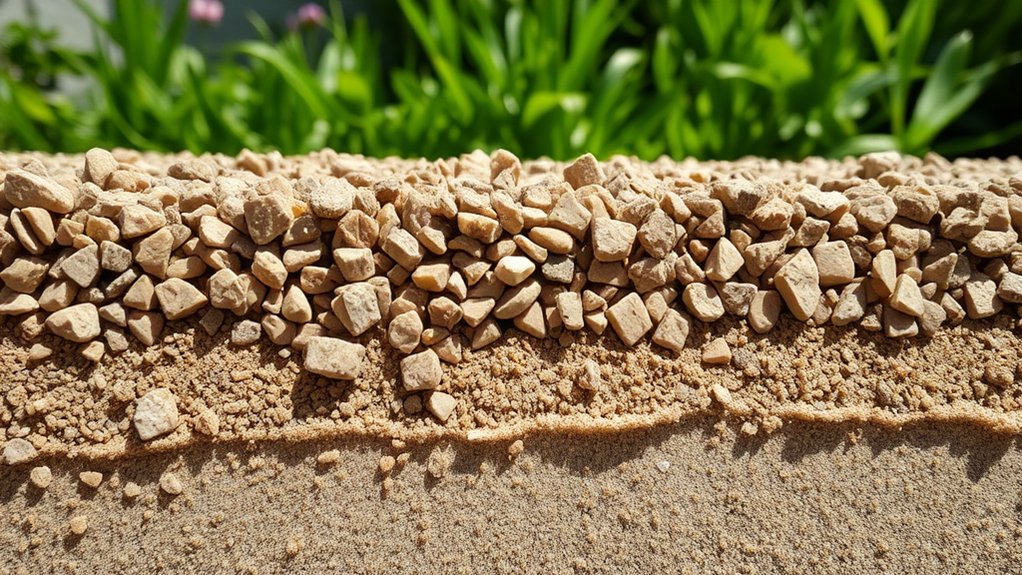
Choosing the right sub-base is crucial for long-lasting resin-bound gravel surfaces. Common materials include:
- MOT Type 3: Perfect for SuDS-compliant driveways and paths. It’s frost-resistant and handles heavy loads well, much like what you’d find under a typical garden patio.
- Porous Concrete: Works brilliantly when mixed correctly for drainage, similar to the base you might see in modern car parks.
- Tarmacadam: Highly practical for areas with heavy foot traffic or vehicles. Think of it as the same tough stuff used in supermarket car parks, but engineered to let water through.
For best results, match your sub-base to your project’s needs. A residential driveway might need different support than a busy shop entrance.
The right foundation keeps your resin surface stable and crack-free for years to come.
Sub-Base Preparation Steps
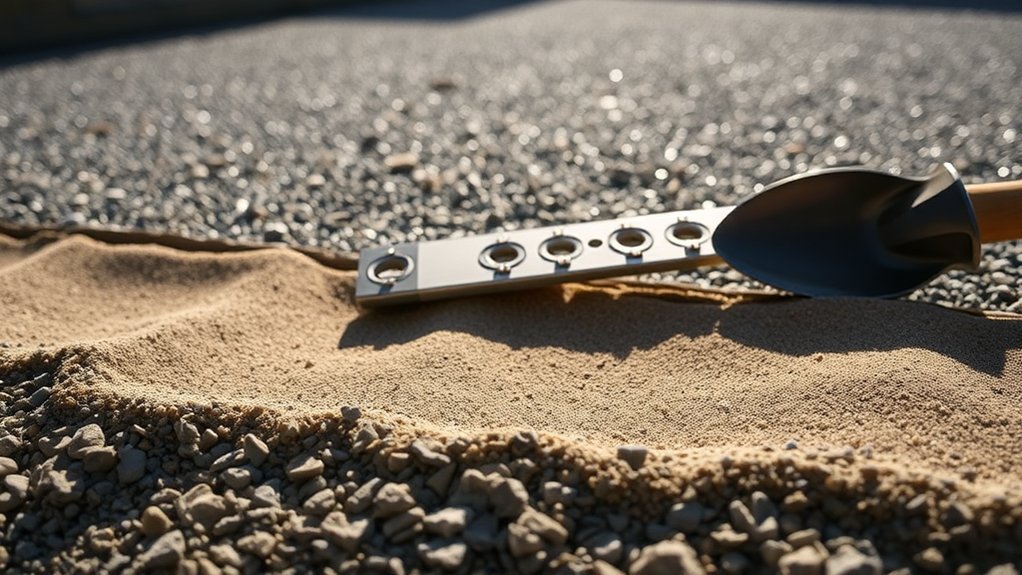
First, assess your site thoroughly, checking for drainage issues, soil quality and any tree roots or utilities.
Dig out the area to the required depth – typically 150mm for domestic driveways or paths.
Compact the soil underneath using a vibrating plate or roller.
Add a layer of hardcore (crushed stone), followed by sharp sand or granite dust, compacting each layer firmly.
Level off using a straight edge, ensuring a slight gradient for water run-off.
The finished sub-base should be solid with no movement when walked on.
Site Assessment Importance
Site Assessment: The Foundation of Success
A proper site assessment makes or breaks a resin-bound gravel project. It’s vital to get it right from the start, as mistakes here often lead to costly repairs down the line.
Three essential checks are needed:
- Drainage Evaluation: Check how water moves across your site. Poor drainage leads to puddles and surface damage – particularly important given the UK’s wet weather. A simple test: pour water on different areas to spot potential problem zones.
- Sub-Grade Stability: Think of this as checking your foundations. The ground needs to be solid and even – if it’s wobbly now, your new surface won’t last. Press firmly across the area; any soft spots need sorting before work begins.
- Soil Type: Different UK soils need different approaches. Clay soil needs extra drainage work, while sandy soil might need more compacting. Getting this wrong risks the whole installation.
Remember: skipping these checks to save time or money usually proves more expensive in the long run.
Excavation and Compaction
Excavate to 220mm depth to create a solid foundation for resin-bound gravel. Remove any existing surfaces, like concrete or block-paving, ensuring proper drainage to avoid puddles.
Lay a geotextile membrane to stop weeds and prevent soil washing away.
For the base, compact thoroughly using a roller or vibro-plate. Think of it like flattening a sandcastle – you want it completely firm and level. The surface should be clean and even, much like preparing a garden path.
Check regularly with a spirit level whilst compacting to prevent dips forming later.
Getting this groundwork right is crucial – it’s like building a house without wobbly foundations. A properly prepared base will ensure your resin-bound surface lasts for years to come.
Material Laying Techniques
After preparing your sub-base, lay the materials for your resin-bound gravel surface using these key steps:
- Lay a geotextile membrane to block weeds and help drainage.
- Use proper base materials (MOT Type 1 or 3) that offer good drainage and stability.
- Keep the base level with a slight gradient to prevent water pooling.
The right installation methods will support your top layer and stop it from cracking.
A properly laid base ensures your surface stays strong and looks professional for years to come.
Challenges and Considerations
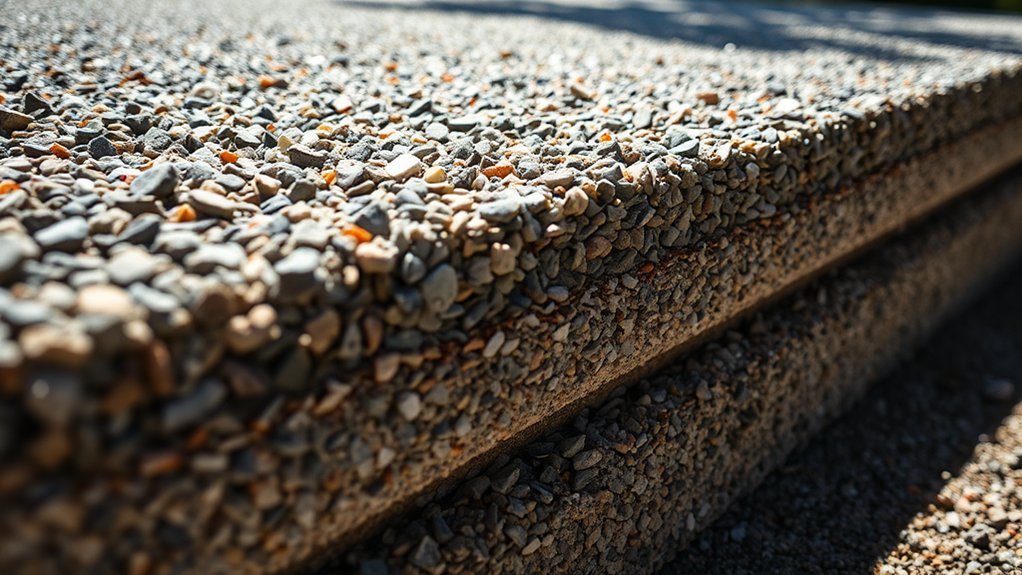
Challenges and Considerations
Several key factors affect resin-bound gravel installation. The sub-base depth must be spot-on – too thin and you’ll risk cracks forming. Proper drainage is crucial, particularly in British weather, to stop water pooling and weakening the surface. Our changeable climate means you’ll need to watch both temperature and moisture levels, as these directly affect how well the resin sets.
| Challenge | Consideration |
|---|---|
| Insufficient Base Depth | Material Stability |
| Poor Drainage | Resin Compatibility |
| Weather Conditions | Aggregate Size |
Tackling these issues from the start ensures your resin-bound surface stays solid and looks proper for years to come.
Benefits of Proper Sub-Base Preparation
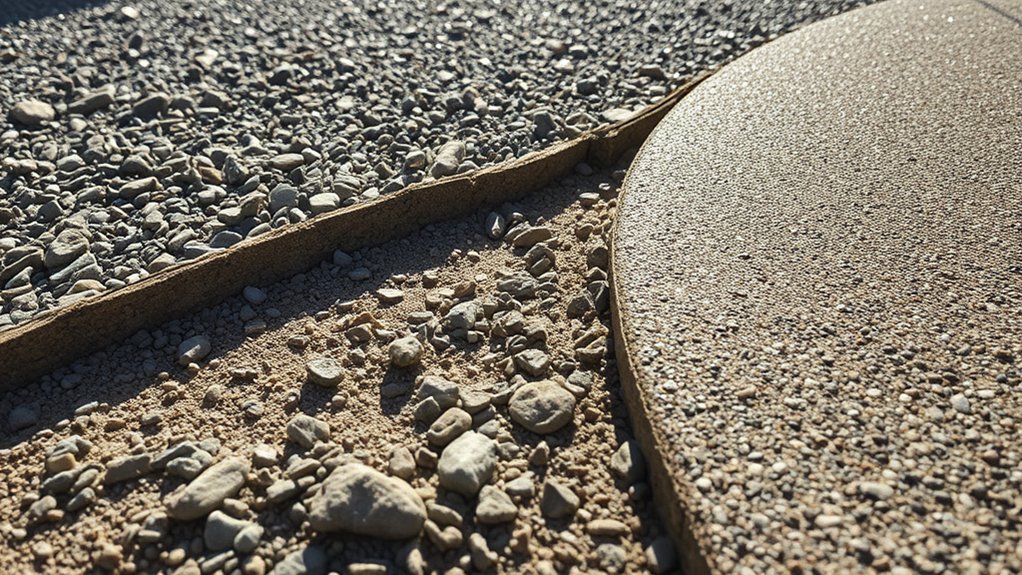
Proper sub-base preparation forms the backbone of any successful resin-bound gravel installation. A well-prepared sub-base delivers three essential benefits:
- Better drainage: Allows rainwater to flow through naturally, meeting UK SuDS requirements
- Longer life: Creates a solid foundation that helps your surface last for years
- Greater stability: Prevents movement and cracking, much like a house needs solid foundations
Think of the sub-base as the foundations of your house – get it right, and everything above stays strong and level.
A properly prepared sub-base ensures your resin-bound surface remains smooth and functional, whilst meeting British environmental standards.
It’s an investment that pays off through reduced maintenance and fewer repairs down the line.
Load-Bearing Capacity of the Sub-Base
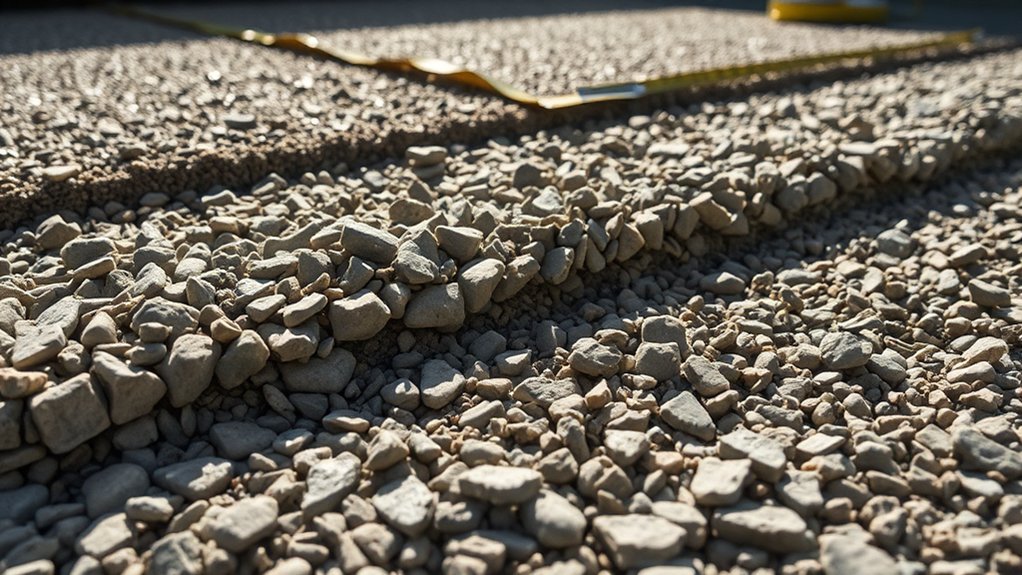
Understanding your sub-base’s load-bearing capacity is vital for any resin-bound surface.
Think of it as the foundation of a house – it must handle everyday weight and pressure without giving way. A properly tested sub-base prevents sinking, cracking and uneven surfaces that could develop under cars, heavy furniture or foot traffic.
For driveways, aim for a sub-base that can support at least 7.5 tonnes per square metre. The wrong capacity choice often leads to costly repairs, so it’s worth getting it right from the start.
Importance of Stability
Stability: The Foundation for Resin Driveways
A solid sub-base acts as the backbone of any resin-bound driveway, much like strong foundations support a house. Without proper stability, even the best resin surface won’t last.
Three essential elements make all the difference:
Sub-base Depth
- Standard depth of 120-150mm works best for domestic driveways
- Deeper bases needed for areas with heavy vehicle traffic, like lorry routes
Material Choice
- MOT Type 1 stone (crushed limestone or granite) remains the UK standard
- Creates a firm, well-draining layer that won’t shift or sink
Proper Compaction
- Each layer needs thorough compacting with a vibrating roller
- Think of it as pressing down a sandwich – no gaps means no weak spots
A properly stabilised base means your resin driveway won’t develop dips, cracks or puddles – saving both hassle and money in the long run.
Load Distribution Factors
Load distribution is crucial for any resin-bound gravel surface to handle traffic pressure effectively. Your sub-base’s strength directly impacts how well it copes with different traffic loads, from family cars on driveways to delivery vans in car parks.
Strong sub-base materials like MOT Type 1 aggregate or concrete are vital. These need proper compaction to at least 100-150mm thickness, though this varies based on your soil’s CBR rating. Think of it as building a sturdy foundation for your house – without it, the structure above won’t last.
The resin-aggregate mix must effectively transfer weight to the sub-base to prevent weak spots. It’s worth testing your sub-base before laying the surface – much like checking ground conditions before building. This step helps determine the right strength and thickness needed, protecting your investment from damage and sinking.
For best results, match your sub-base to expected usage. A residential driveway needs less reinforcement than a busy shop car park, but both require proper preparation to avoid costly repairs later.
Drainage Compliance and Efficiency
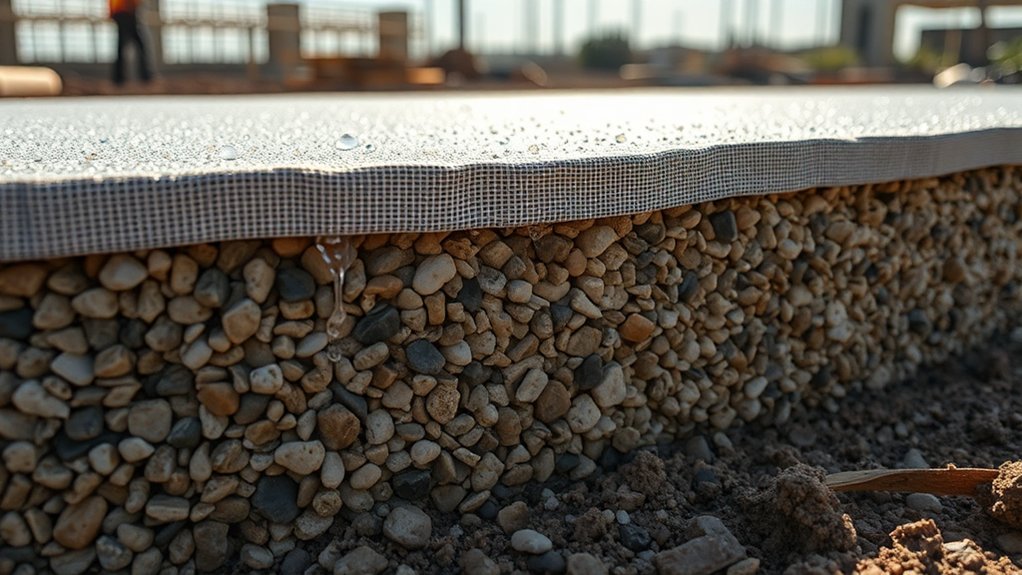
Getting Drainage Right for Resin-Bound Surfaces
Proper drainage forms the backbone of any successful resin-bound installation.
Three critical elements ensure water flows correctly through your surface:
Permeable Base
MOT Type 3 aggregate creates an effective foundation that absorbs water naturally – much like a well-draining garden soil.
Proper Compaction
A firmly compacted sub-base prevents water pooling and protects against flooding, similar to how packed gravel paths drain effectively.
Gradient Planning
A gentle 1-2% slope, roughly the same as a typical garden path, moves water away from the surface efficiently.
These basics help avoid common issues like puddles and water damage, whilst meeting UK building regulations for sustainable drainage systems (SuDS).
Surface Stability and Performance
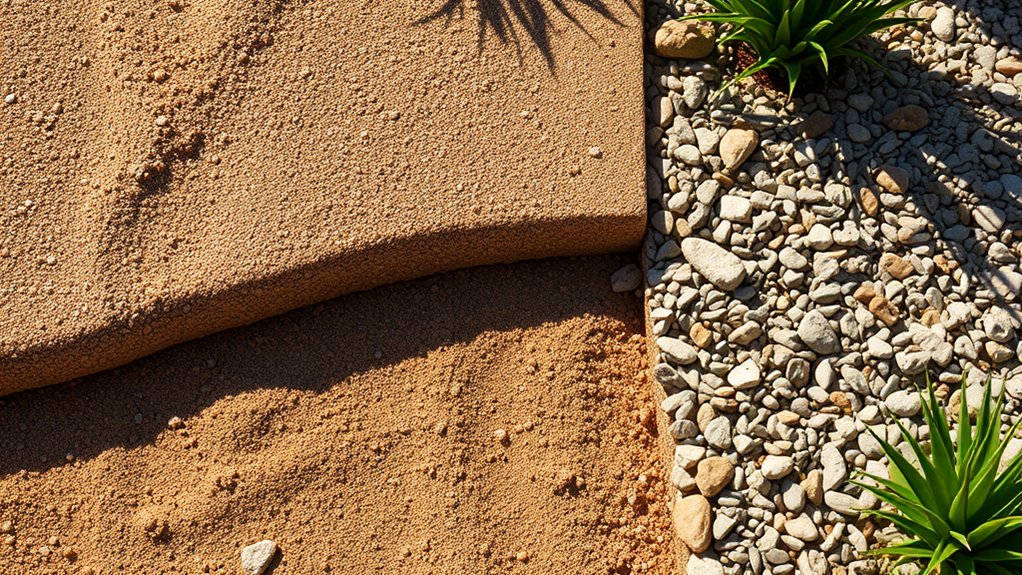
Proper sub-base preparation is vital for resin-bound gravel surfaces to perform well and remain stable. The thickness and compaction of your sub-base matter greatly – get these wrong, and you’ll likely face cracking and dips in the surface.
Think of the sub-base as the foundation of a house; it needs to be rock-solid. A properly compacted sub-base spreads weight evenly across the surface, much like how a good mattress distributes body weight. Without this, you’ll end up with annoying bumps and dips where the ground has settled unevenly.
The firmer and more level your sub-base, the better your resin surface will hold up. For driveways especially, a strong sub-base is crucial. It needs to handle everything from daily car parking to the occasional heavy delivery lorry without showing signs of wear.
Sort out your sub-base properly from the start, and your resin-bound surface will stay looking smart and performing well for years to come.
Material Selection for Optimal Results
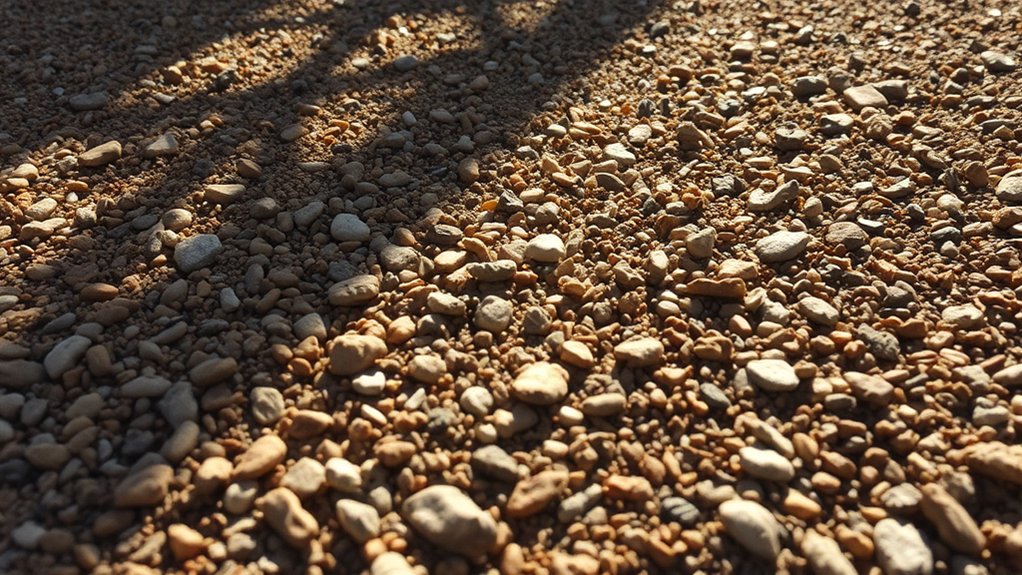
Choosing the Right Sub-base Materials
The right sub-base materials are crucial for a lasting resin-bound gravel surface:
- MOT Type 3 delivers outstanding strength and frost resistance, with excellent drainage properties to prevent sinking.
- Porous concrete meets environmental standards through water permeability, ticking the box for Sustainable Drainage Systems (SuDS).
- Open-graded tarmacadam is SuDS-compliant but needs proper curing time during installation.
Quality materials strengthen your surface whilst meeting environmental rules.
Think of your sub-base as the foundation of a house – get it right, and you’ll save time and money on repairs down the line.
Maintenance of the Sub-Base System
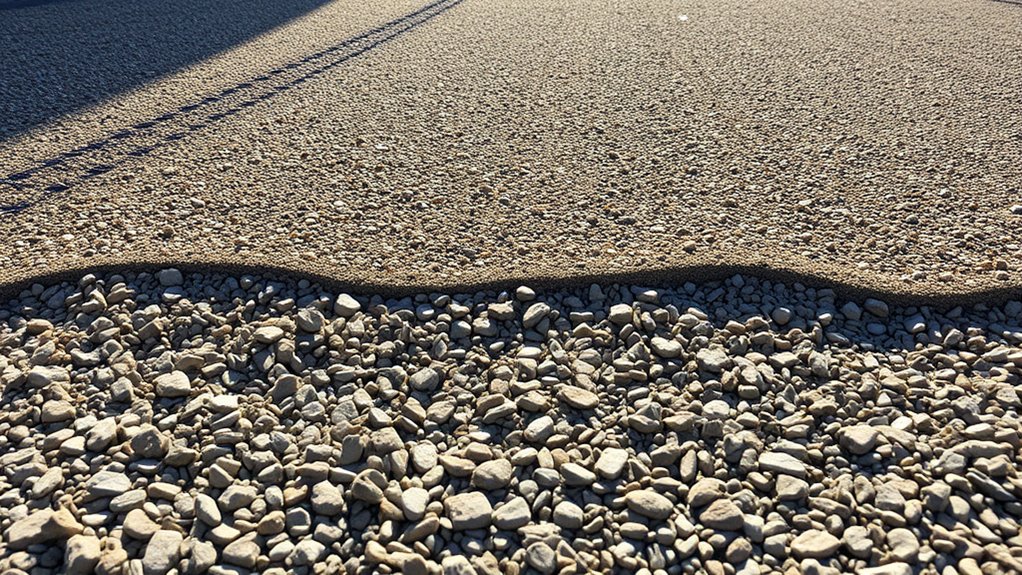
Regular checks of your resin-bound gravel’s sub-base system are vital for its long-term performance.
Check the surface after heavy rain or when seasons change, looking out for soft spots or puddles. Use gentle cleaning methods – avoid pressure washers as they may damage the surface.
Give drains a monthly once-over to ensure water flows away properly. Sort out any cracks or movement straight away; small problems can quickly become big ones if left unchecked.
Keep the surface slope consistent for proper drainage, and remove leaves and debris from drains before they cause blockages. For areas that see lots of foot traffic, make sure the sub-base is properly compacted with suitable materials.
Don’t forget to check anti-slip treatments periodically – they’re especially important during wet British weather. A well-maintained sub-base means fewer repairs and a longer-lasting surface.
Frequently Asked Questions
How Long Does Sub-Base Preparation Typically Take?
Sub-base preparation usually takes between one and four days, though this varies based on the materials used and site conditions. The timeframe largely depends on the project’s scope – a small garden patio might take a day, whilst a large driveway could need the full four days. Weather plays a crucial role too; wet conditions can significantly slow the process, as proper drainage and compaction are essential for a sturdy foundation.
Can I Install Resin-Bound Gravel Myself?
Whilst it’s possible to lay resin-bound gravel yourself, it’s a job that requires careful attention to detail and proper technique. The key is thorough base preparation, precise mixing of materials and swift application – as the resin sets quickly. Bear in mind that mistakes can be costly and difficult to correct, much like laying concrete. For best results, consider hiring a professional, especially if you’re covering a large area or haven’t tackled similar projects before.
What Tools Are Needed for Sub-Base Preparation?
Proper sub-base preparation requires several essential tools to ensure a stable foundation. A complete toolkit includes excavators or diggers, plate compactors, wacker plates, laser levels, and wheelbarrows. You’ll also need geotextile membranes to prevent soil mixing, plus Type 1 MOT (Ministry of Transport) or similar crushed aggregate materials. Think of it like laying a carpet – without a proper underlay, the surface above will soon become uneven and unstable.
How Often Should the Sub-Base Be Inspected?
Regular sub-base inspections should be carried out four times yearly, matching the seasons, with additional checks after severe weather. Focus particularly on autumn and spring inspections, as these follow the most challenging weather periods. A consistent inspection schedule helps spot issues like drainage problems or settling before they affect the surface above.
Are There Specific Weather Conditions for Installation?
Weather conditions significantly impact installation success. Install in dry conditions when temperatures are between 10°C and 25°C to ensure proper curing. Damp or extreme temperatures can compromise the final results.
Conclusion
A solid sub-base makes all the difference with resin-bound gravel installations. Getting it right from the start means you’ll avoid costly repairs and drainage issues down the line. Proper preparation involves choosing quality materials and following correct installation methods – much like building a house on strong foundations. The result? A stable, long-lasting surface that drains properly and stands up to British weather. Money spent on thorough sub-base work is a sound investment that pays off in reduced maintenance and fewer headaches later.
